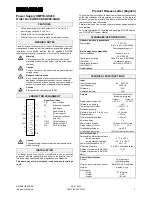
WARNING: Some dust created by power sanding, sawing, grinding, drilling, and
other construction activities contains chemicals known to the State of California
to cause cancer, birth defects or other reproductive harm. Some examples of
these chemicals are:
• lead from lead-based paints,
• crystalline silica from bricks and cement and other masonry products, and
• arsenic and chromium from chemically-treated lumber.
Your risk from these exposures varies, depending on how often you do this type of
work. To reduce your exposure to these chemicals: work in a well ventilated area, and
work with approved safety equipment, such as those dust masks that are specially
designed to filter out microscopic particles.
•
Avoid prolonged contact with dust from power sanding, sawing, grinding, drilling,
and other construction activities. Wear protective clothing and wash exposed
areas with soap and water.
Allowing dust to get into your mouth, eyes, or lay on the
skin may promote absorption of harmful chemicals.
WARNING: Use of this tool can generate and/or disperse dust, which may cause
serious and permanent respiratory or other injury
. Always use NIOSH/OSHA
approved respiratory protection appropriate for the dust exposure. Direct particles away
from face and body.
WARNING: ALWAYS use safety glasses. Everyday eye glasses are NOT safety
glasses. Also use face or dust mask if cutting operation is dusty. ALWAYS WEAR
CERTIFIED SAFETY EQUIPMENT:
•
ANSI Z87.1 eye protection (CAN/CSA Z94.3)
•
ANSI S12.6 (S3.19) hearing protection
•
NIOSH/OSHA/MSHA respiratory protection
SYMBOLS
The label on your tool may include the following symbols.
V ..........................volts
A..........................amperes
Hz ........................hertz
W ........................watts
min........................minutes
......................alternating
current
........................direct current
no........................no load speed
..........................Class II Construction
........................earthing terminal
........................safety alert symbol
.../min ..................revolutions
per minute
• When using an extension cord, be sure to use one heavy enough to carry the current
your product will draw. An undersized cord will cause a drop in line voltage resulting in
loss of power and overheating. The following table shows the correct size to use
depending on cord length and nameplate ampere rating. If in doubt, use the next
heavier gauge. The smaller the gauge number, the heavier the cord.
Recommended Minimum Wire Size for Extension Cords
Total Length of Cord
25 ft.
50 ft.
75 ft.
100 ft.
125 ft.
150 ft.
175 ft.
7.6 m
15.2 m
22.9 m
30.5 m
38.1 m
45.7 m
53.3 m
Wire Size AWG
18
18
16
16
14
14
12
SAFETY WARNINGS AND INSTRUCTIONS: BATTERIES
• Donotdisassembleoropen,drop(mechanicalabuse),crush,bendordeform,puncture,orshred.
• Do not modify or remanufacture, attempt to insert foreign objects into the battery,
immerse or expose to water or other liquids, or expose to fire, excessive heat including
soldering irons, or put in microwave oven.
• Only use the battery / tool with a charging system specified by the
manufacturer/supplier.
• Do not short-circuit a battery or allow metallic or conductive objects to contact both
battery terminals simultaneously.
• Dispose of used batteries promptly according to the manufacturer/supplierʼs instructions.
4





































